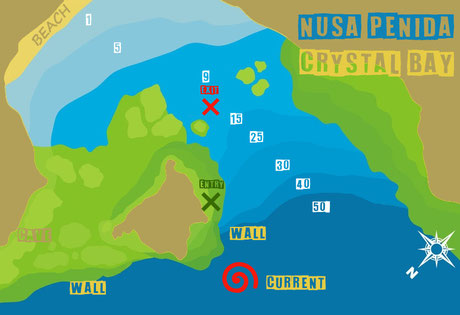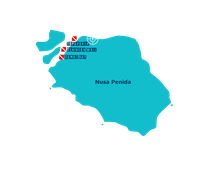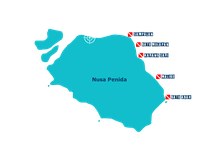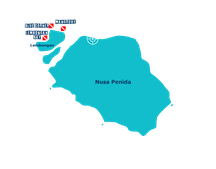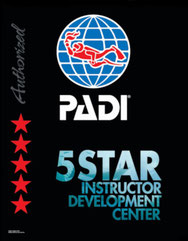West Nusa Penida dive sites
The west coast of Nusa Penida is the most famous due to two major dive sites, Crystal Bay and Manta Point. We dive Manta Point and Crystal Bay almost everyday during peak season. Manta rays are present year round in Manta Point except for a few rare weeks when they migrate to reproduce. The Mola Mola also known as Ocean Sunfish is Nusa Penida's diving mascot and also our dive center logo. Ocean sunfish can be found on almost all Nusa Penida dive sites, however Crystal Bay, Blue Corner and the Nusa Penida north coast are the dive sites with the more reported sightings. Crystal Bay has ideal topography for upwelling current (and down-welling!) which allows mola mola to come to shallower depths, perfect for a stop at a cleaning station. The Manta Bay dive site is popular to spot small manta rays, either diving or snorkeling. Batu Bolong is an exceptional dive site and really not often visited as conditions can be tricky and currents unpredictable.
Diving
Nusa Penida
Meet the majestic Manta rays
Manta Point
Manta point is simply magical. Who hasn't dreamed of diving with manta rays?
The dive site is perfect for meeting majestic manta rays, they come to the cleaning station to have parasites removed and this gives you time to watch the show. The dive site also has very interesting topography.
- Difficulty : Beginner to expert
- Max depth : 40+ m
- Visibility : really good to low
- Temperature : 18 to 30 (average 23°c)
- Currant : none to medium (strong surge possible)
The main attraction of the dive site is of course Manta rays. We are lucky to be able to spot them year round in Nusa Penida. The entry point is in front of the cleaning station, where divers descend to a depth of about 10 meters and move towards the station having already seen some manta rays. On the station, Manta will stay if they are not disturbed. The manta code of conduct will be explained during your briefing.
Manta point is an extraordinary dive site when you know how to do it correctly. Sometimes when there are fewer Manta rays, your guide will explore the plateau and check the smaller cleaning station. The water can be a little colder at Manta point, which is why we do not stay static too long at the cleaning station and prefer to do some exploration.
The east part of Manta point is quite pretty and has fewer divers. Here some guides choose to go east after seeing the manta rays on the station, in order to do a loop and exit near the entry point. This option is perfect for training dives and for beginners.
Another option, and this is the one we prefer, is to go west. It's a whole different dive! In order to save air we don't want to go too deep, the target is to go to the end of drop off. Along the way the topography changes with huge boulders acting as a "cathedral" rising almost to the surface. Between these large boulders there are very playful swim-throughs (like small tunnels) and crevasses - it's a bit like a labyrinth. The most surprising thing is that along the way you can still meet manta rays but also eagle rays and a lot of sharks (especially bamboo). Once this passage is behind us, here is the beginning of the drop off. Are mola mola possible here? Absolutely! Near the end of the wall, very intimidating-looking stingrays are often spotted. Time flies and it is time to do our safety stop drifting in the blue.
Diving is more "mineral" at Manta Point, there are a lot of corals but you can immediately understand that the surge (which can be very strong) prevents the corals from developing, so they are very resistant and quite " stocky ". The fauna is very rich with an abundance of blue-spotted stingrays in the sandy part but also a lot of nudibranchs, octopuses, coral reef fishes and turtles.
Diving
Crystal Bay
The Mola Mola quest
Crystal Bay
Crystal Bay is one of the most famous dive sites in Nusa Penida and for good reason! It is the historic dive site where the giant Mola Mola can be spotted (usually from July to November). The dive site is simply magical and there are so many ways to dive it that you just can't get enough.
- Difficulty : Beginner to expert
- Max depth : 40+ m
- Visibility : really good to good
- Temperature : 18 to 28 (average 23°c)
- Currant : none to really strong
Previously Crystal Bay was popular mainly to encounter Mola-Mola. Today we dive Crystal Bay in various ways depending on the season, the level of the divers and the conditions. For an Ocean Sunfish dive it is imperative to follow an experienced guide in order to ensure a high level of safety. We like to get into the water close to the drop off and the "corner" in order to prevent long swims underwater toward the slope where the Mola-Mola ascend from the deep blue. On the slope after the first corner your guide will analyze the conditions, mostly current, and fish behavior. If conditions allow you will reach second corner and stay a few minutes in this area looking at the blue. In rare conditions it is possible to go around the island but mostly your guide will come back to the plateau at a shallower depth. The plateau is really nice, with a huge variety of fishes and corals that are really colorful. The topography is also very pleasant on the North of the island with 3 mini canyons where you will have the pleasure to feel the surge. The end of the dive above the sandy bottom of the bay is ideal for the safety stop or if you still have air why not explore the pretty reef on the south side.
The reef on the south side of the bay is ideal for discover scuba diving or training dives. Corals and fauna will delight divers and it is not uncommon to see the Mola Mola on this side as well.
The fauna is very rich and besides Mola Mola, Crystal Bay offers lucky divers many other big fishes, manta, barracuda, giant trevally, tuna, whale sharks and in 2019 some divers were lucky enough to see a great white shark!
The macro fauna is not left out with many frog fish more often juveniles, moray eels, wobbegong, sharks, various nudibranchs, shrimps and crabs. In certain cases and if the conditions allow it, your guide will be able to guide you to the bat cave. If surfacing in the cave you will encounter a pretty large bat colony. A word of advice, keep your mask and your regulator on. The smell is quite strong!
Batu Bolong
Batu Bolong (Batu meling) is Nusa Penida's prestigious site. The translation means "Pierced rock" and this is what we see from the surface. Underwater is a festival both in terms of fauna and sensations! A dive site to respect where mother nature shows us that she is still in control...
- Difficulty : Expert
- Max depth : 40+ m
- Visibility : really good to bad
- Temperature : 18 to 28 (average 23°c)
- Currant : none to really strong

This dive site is not for all divers. A negative entry is necessary to reach the plateau as quickly as possible. Unpredictable currents can modify the dive, ideally the entry point is East of the drop off, the current pushing us on the plateau. It is imperative to reach the bottom as quickly as possible in order to not get carried away by the current ...
Once down you will understand why Batu Bolong is so popular with divers. Thousands of Moorish idols are waiting for big fishes. Moorish idols and angel fish are the best cleaner fish for Mola Mola. And they are not alone, Mola Mola, eagle rays, marbled rays, tuna, sharks of all kinds visit these cleaner fish.
Despite this site being so popular we reserve it for our best divers with whom we have already dived and who are in need of thrills. Few of our guides are able to guide Batu Bolong, it is mandatory to know the dive site and currents perfectly. As Divemaster or Instructor Candidates we will ensure you get to Batu Bolong durong your training with Bali Aqua Nusa Penida.
Manta Bay
Manta Bay is for many of us the "false" manta point. In fact, many operators call it manta point in order to save gasoline due to its closer proximity. It is a very pretty site but manta rays can be more difficult to spot.
- Difficulty : Beginner to good
- Max depth : 25+ m
- Visibility : really good to mild
- Temperature : 20 to 28 (average 25°c)
- Currant : none to low (surge possible)

The Manta Bay dive site is undoubtedly the most visited by operators seeking to minimize their costs. Much closer than Manta Point and offering a good probability of encountering manta rays, it is however difficult to guarantee an encounter due to the excessive presence of snorkelers. Often we see mantas from the boat, but once in the water it is much more difficult to spot them ... You therefore need all the dexterity of your guide to be able to see them. Manta Bay is perfect for snorkelers as they are faster and can have a surface spotter (boat crew) to guide them.
The site itself is quite large and will make most divers happy. There are several ways to approach the dive site depending on the conditions and the presence of manta rays. Start diving near the island and then look for rays on the plateau. A cleaning station exists at 18 meters and sometimes it has good surprises. This dive site is more for beginners or our experienced divers wanting a solid, relaxing dive.
Other Nusa Penida dive sites
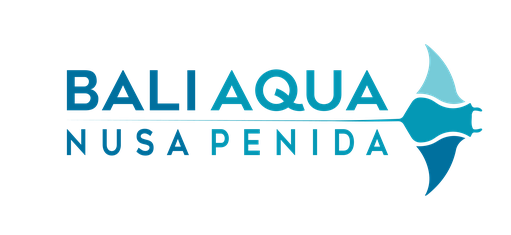
Jalan Raya PED, Buyuk - Nusa Penida - 80771, Bali
Dive center Whatsapp : +62 823 3975 1705
Reservation (wa): +62 812 3727 0003
- Quick Link -
Bali Aqua © 2008-2025 "made with love and lots of diving enthusiasm"



